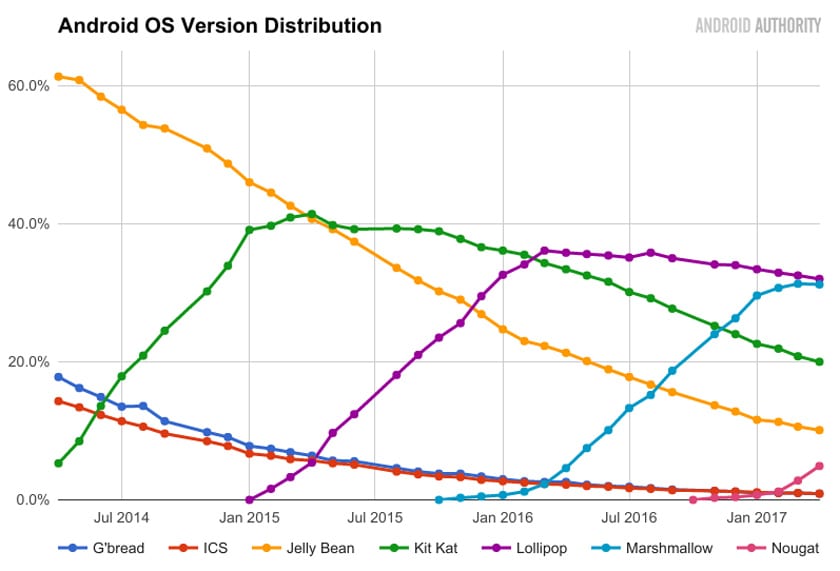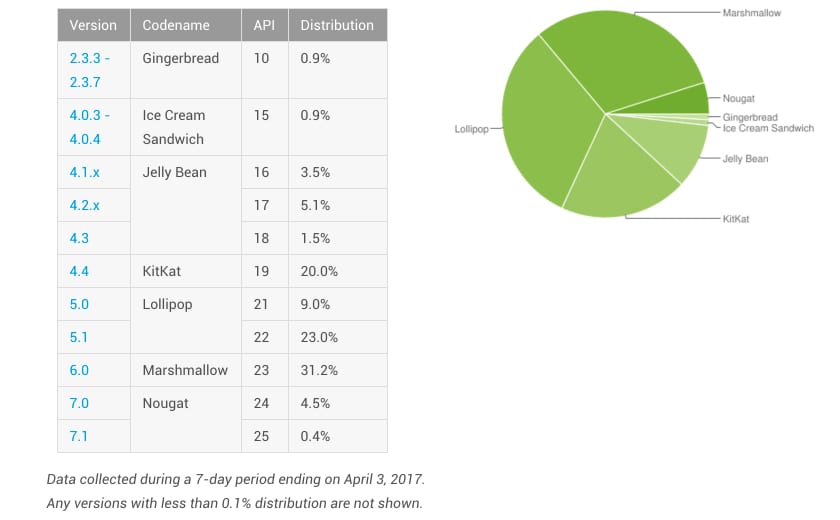
The latest distribution figures for the different versions of the Android operating system have already been published and as regards the latest of these versions, Android Nougat has continued its expansion during the month of March, although not at as high a speed as during the previous month, reaching almost 5% of active Android mobile devices.
Specifically, Android Nougat is installed in 4,9% of devices as a combined result of the two current versions of this operating system: 7.0 with 4,5% and 7.1 with 0,4%.
Slower adoption
Taking a look at the distribution history of the different versions of Android prepared by the guys from Android Authority, it is observed that "The absorption rate of each new version of Android seems to be decreasing", so we will still have to wait a couple of months to see if the adoption curve of Android Nougat (in the graph below) coincides more with that of Android KitKat or with that of Android Marshmallow.
On the other hand, at a time when Android Marshmallow updates are still rolling out for many devices, it is likely that "Marshmallow's saturation point may still be to come".

Why does each new version of Android take longer to reach devices?
Obviously, an interesting question arises from the previous graph: what is happening? Why does each new version of Android reach fewer devices and do it more slowly? The answers to this question can be several.
Firstly, some experts accuse some OEMs of taking more time to roll out updates than in previous years. Indeed, this could explain that weaker deployment curve that we have seen in the graph that I have left above, however, the truth is that four large original equipment manufacturers released their first Android Nougat updates during the first hundred days since their official release.
Second, we have just the opposite explanation, that is, if original equipment manufacturers (OEMs) update their devices to a newer version of Android more quickly, the oldest version of the operating system, logically, will not be available on so many devices. Thus, it has been seen how in the past several OEMs have skipped versions of the operating system to launch a new Android update. This, they explain again from Android Authority, "could explain the constant saturation of previous versions of Android in the graph."
Third, another aspect to consider is that the global smartphone market is relatively saturated and Several OEMs have released fewer devices each year, which would affect that weaker or slower adoption rate of new versions of the Android operating system.
But there are still more possible reasons, the fourth of which is that users hang on to their devices longer, which causes the number of active devices running previous versions of Android to remain high, something that we can see reflected in the graph by the slower rate of fall of each successive version of Android OS.
Another factor could be launching new devices without the latest version of AndroidA "custom" that is due to the rise of lower-cost Chinese devices and higher market growth in developing countries.
However, the earlier and earlier release of new versions of AndroidThis is probably the main reason: Jelly Bean was in effect for almost 16 months, KitKat was just over a year; Lollipop, 11 months, and finally Marshmallow, XNUMX months, until Nougat arrived last August. And in fact, the version that has been in force for the least time is the one that has had the least penetration in the market.

Looking at the current distribution table published, and with smartphone security an increasingly worrisome issue, Android fragmentation is an issue that will likely be addressed in the Google I/O 2017 and on which Google must pronounce and act. The figures speak for themselves: more than 80% of active devices in the last month have KitKat, Lollipop or Marshmallow, all of them previous systems.